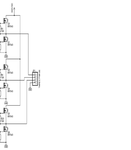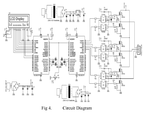Okada
Banned
I am designing 3 Phase Induction Motor V/F Control. I am planning to using dsPIC33FJ32MC202. There will be 6 SPWM signals. I want to know will there be 3 complementary sine wave PWMs ?
If yes, which signals are Complementary ?
The signals are
PWM1H1
PWM1L1
PWM1H2
PWM1L2
PWM1H3
PWM1L3
I am planning to use IRF540 for the driver stage.
My requirement is that I have to drive a 7.5KW Induction Motor. What should be the power rating of the power output stage ?
To increase the Power output should I use multiple IRF540 in parallel that is I have 6 SPWM channels and should I have say 8 to 10 IRF540 in each channel and in parallel to get the required power ?
Till now I have used PIC and generated 3 SPWM signals. If the other 3 signals are complementary that is 180 degree Phas shifted with the normal signal then I will use Not gates to get the other 3 signals and use PIC only. If this is not possible then I will use dsPIC33 but I don't know how to generate SPWM signals using dsPIC33. If needed I can post my PIC SPWM code.
Between PIC and Power stage there will be opto isolators.
The IRF540 circuit is like this. Should I add 1 more IRF540 in parallel to each IRF540. IRF540 is rated for continuous drain to source current of 28 A.
My IM is rated at 7.5KW
IRF540 can handle VDS = 100 V DC.
If yes, which signals are Complementary ?
The signals are
PWM1H1
PWM1L1
PWM1H2
PWM1L2
PWM1H3
PWM1L3
I am planning to use IRF540 for the driver stage.
My requirement is that I have to drive a 7.5KW Induction Motor. What should be the power rating of the power output stage ?
To increase the Power output should I use multiple IRF540 in parallel that is I have 6 SPWM channels and should I have say 8 to 10 IRF540 in each channel and in parallel to get the required power ?
Till now I have used PIC and generated 3 SPWM signals. If the other 3 signals are complementary that is 180 degree Phas shifted with the normal signal then I will use Not gates to get the other 3 signals and use PIC only. If this is not possible then I will use dsPIC33 but I don't know how to generate SPWM signals using dsPIC33. If needed I can post my PIC SPWM code.
Between PIC and Power stage there will be opto isolators.
The IRF540 circuit is like this. Should I add 1 more IRF540 in parallel to each IRF540. IRF540 is rated for continuous drain to source current of 28 A.
My IM is rated at 7.5KW
IRF540 can handle VDS = 100 V DC.
Attachments
Last edited:

